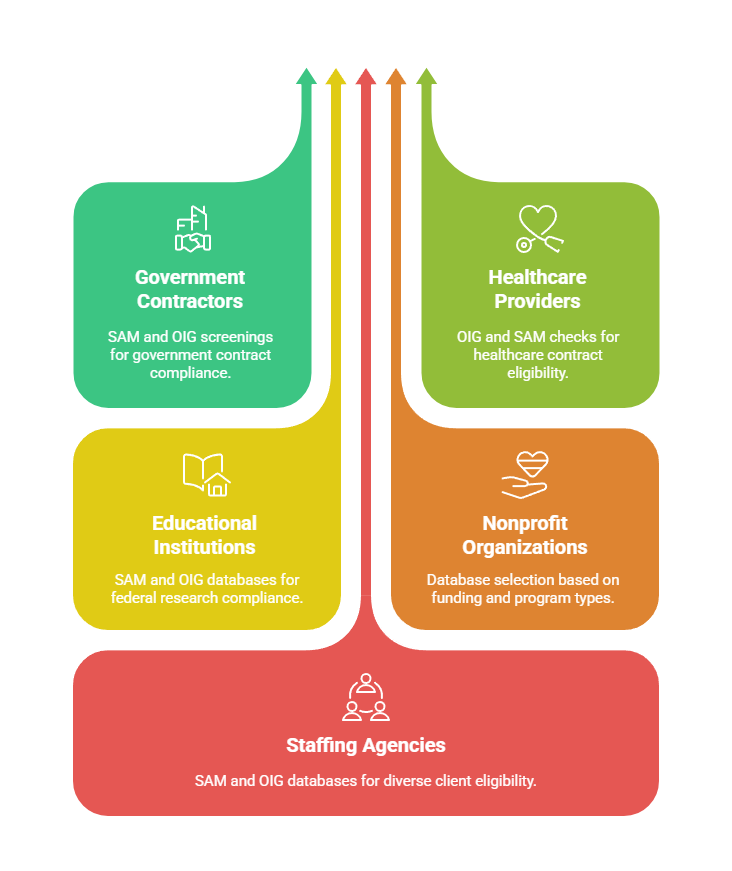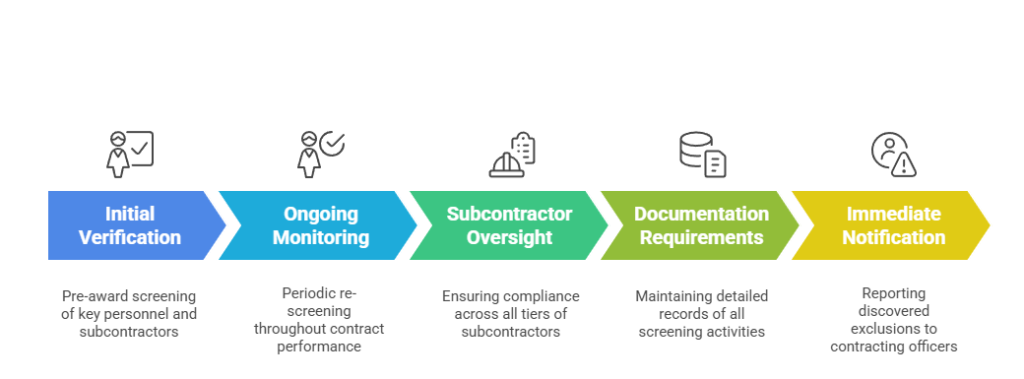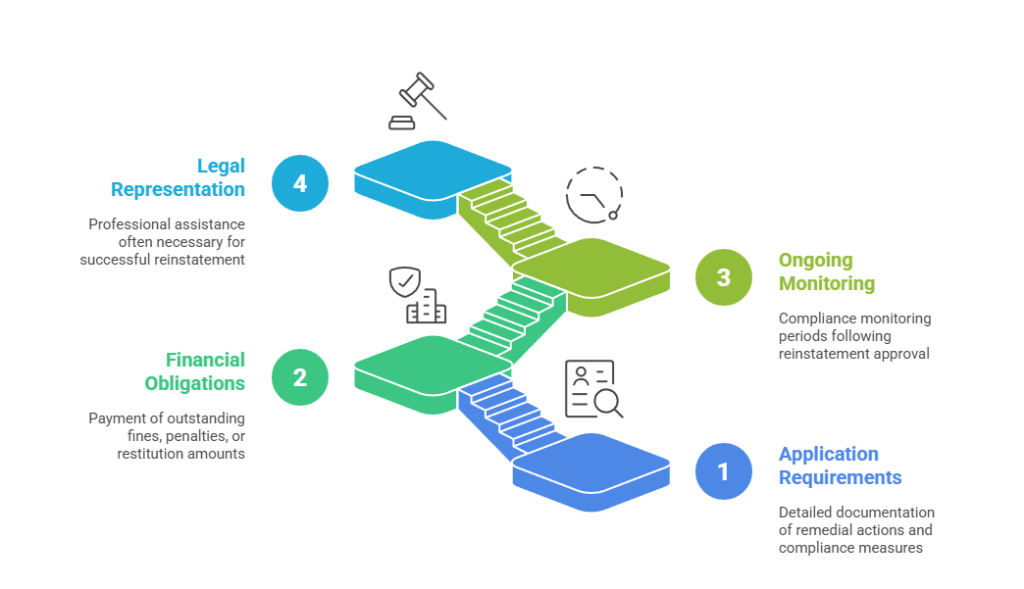The difference between SAM and OIG exclusion screening lies in their scope and purpose: SAM (System for Award Management) tracks entities barred from federal contracts and grants, while OIG (Office of Inspector General) exclusions specifically target healthcare providers prohibited from participating in federal healthcare programs like Medicare and Medicaid. Understanding both databases is crucial for employers conducting comprehensive background checks and ensuring compliance with federal regulations in 2025.
Key Takeaways
- SAM exclusions apply to all federal contracting and grant opportunities across government agencies, making them essential for any organization doing business with the federal government.
- OIG exclusions specifically target healthcare workers and entities, focusing on individuals barred from Medicare, Medicaid, and other federal healthcare programs.
- Healthcare employers must check both databases during background screening, as an individual could be excluded from one system but not the other.
- Federal contractors outside healthcare primarily need SAM screening, though comprehensive background checks should include both databases for maximum protection.
- Exclusion periods vary significantly between systems, with SAM exclusions often being temporary while OIG exclusions can be permanent depending on the violation.
- Regular re-screening is required for both databases, as exclusions can be added or removed at any time, potentially affecting employee eligibility.
Understanding Federal Exclusion Databases
Federal exclusion databases serve as critical tools for maintaining integrity in government programs and contracts. The System for Award Management (SAM) and the Office of Inspector General's List of Excluded Individuals/Entities (OIG LEIE) represent two distinct but equally important screening mechanisms. These databases help employers avoid hiring individuals who could jeopardize their organization's ability to participate in federal programs or receive government funding.
The complexity of federal exclusion screening often creates confusion among HR professionals and staffing agencies. While both databases serve protective functions, they operate under different regulatory frameworks and target different types of violations. Understanding when and how to use each database ensures comprehensive compliance and risk mitigation for your organization.
Modern background check procedures in 2025 require employers to navigate an increasingly complex regulatory landscape. Federal agencies continue to enhance their screening requirements and enforcement mechanisms. Therefore, staying current with both SAM vs OIG screening requirements becomes essential for maintaining business continuity and avoiding costly compliance violations.
What is SAM Exclusion?
The System for Award Management exclusion database contains records of individuals and entities prohibited from participating in federal procurement and nonprocurement programs. SAM exclusions stem from various violations including contract fraud, environmental crimes, tax delinquency, and failure to meet contractual obligations. These exclusions prevent entities from receiving federal contracts, grants, loans, or other forms of federal financial assistance.
SAM exclusions can be either discretionary or mandatory, depending on the nature of the violation. Discretionary exclusions allow federal agencies flexibility in determining appropriate penalties, while mandatory exclusions automatically trigger when specific statutory or regulatory violations occur. The database includes detailed information about the exclusion reason, effective dates, and any restrictions on future participation in federal programs. Additionally, the system provides cross-references to related entities and individuals who may also be affected by the exclusion.
Organizations subject to SAM exclusions face significant business consequences beyond losing existing federal contracts. Excluded entities cannot bid on new opportunities or receive subcontracts funded by federal money. This comprehensive restriction extends to all federal agencies, making SAM screening essential for any business involved in government contracting or grant-funded activities. Furthermore, the exclusion affects all subsidiaries, affiliates, and related entities, creating widespread business impact.
What is OIG Exclusion?
Healthcare-Focused Enforcement

OIG exclusions specifically target individuals and entities in healthcare who have violated laws related to federal healthcare programs. The Office of Inspector General maintains the List of Excluded Individuals/Entities (LEIE) to prevent fraudulent or abusive practitioners from participating in Medicare, Medicaid, and other federal healthcare initiatives. Common reasons for OIG exclusion include healthcare fraud, patient abuse, drug-related convictions, and license revocations.
Types of OIG Exclusions
OIG exclusions fall into two primary categories: mandatory and permissive exclusions. Mandatory exclusions automatically apply to specific offenses such as Medicare or Medicaid fraud convictions, while permissive exclusions allow OIG discretion based on circumstances. The database provides detailed exclusion information including the individual's specialty, exclusion date, and reinstatement eligibility requirements. Each entry also contains the specific statutory authority for the exclusion and any applicable waiver provisions.
Key Differences Between SAM and OIG Screening
Understanding the fundamental differences between these systems helps employers develop appropriate screening protocols. SAM focuses broadly on federal contracting integrity across all government agencies and programs. In contrast, OIG LEIE vs SAM database comparisons show that OIG concentrates exclusively on healthcare program protection and fraud prevention.
| Aspect | SAM Exclusion | OIG Exclusion |
| Primary Focus | Federal contracting and grants | Healthcare programs only |
| Scope | All federal agencies and programs | Medicare, Medicaid, federal health programs |
| Industries Affected | Government contractors, nonprofits, all federal recipients | Healthcare providers, facilities, related entities |
| Exclusion Triggers | Contract violations, fraud, environmental crimes, tax issues | Healthcare fraud, patient abuse, license issues |
| Reinstatement Process | Varies by agency and violation type | Formal application process with specific requirements |
These differences directly impact which screening approach employers should adopt based on their industry and federal involvement. A technology contractor working with the Department of Defense primarily needs SAM screening, while a hospital must prioritize OIG checks but should also verify SAM status for comprehensive compliance.
When to Use Each Database
Federal contractors and grant recipients must prioritize SAM exclusion screening as part of their standard background check procedures. Any organization receiving federal funding, bidding on government contracts, or participating in federal programs should verify that employees, subcontractors, and key personnel are not SAM-excluded. This screening becomes particularly critical for positions involving contract management, financial oversight, or direct program implementation.
Healthcare organizations require mandatory OIG screening for all employees, contractors, and volunteers who could influence federal healthcare program decisions. This includes clinical staff, administrators, board members, and vendors with access to patient information or billing systems. The Centers for Medicare & Medicaid Services (CMS) requires healthcare providers to screen against the OIG LEIE database monthly and maintain documentation of their screening efforts. Recent 2024 enforcement actions have demonstrated increased scrutiny of healthcare provider compliance with these requirements.

- Government contractors: Primary SAM screening with secondary OIG verification for comprehensive protection
- Healthcare providers: Mandatory OIG screening with additional SAM checks for federal contract participation
- Educational institutions: Both databases for comprehensive compliance, especially with federal research funding
- Nonprofit organizations: Database selection based on funding sources and program types
- Staffing agencies: Both databases to serve diverse client needs and ensure candidate eligibility
Smart employers implement dual-database screening regardless of industry focus. This comprehensive approach provides maximum protection against hiring excluded individuals who could jeopardize federal program participation or funding eligibility.
Impact on Employment and Background Checks
Employment Consequences
Exclusion from either database significantly affects an individual's employment prospects and career trajectory. SAM exclusions prevent individuals from working for federal contractors in positions that could influence contract performance or compliance. Similarly, OIG exclusions prohibit healthcare workers from participating in any capacity within organizations that bill federal healthcare programs.
Employer Risks and Responsibilities
Employers face substantial risks when hiring excluded individuals, including contract termination, funding suspension, and potential civil or criminal penalties. These consequences extend beyond the individual employee to affect entire organizations and their federal program participation. Regular screening and re-screening protocols help mitigate these risks and ensure ongoing compliance. Additionally, employers must maintain detailed documentation of their screening efforts to demonstrate good faith compliance during audits or investigations.
Compliance Requirements and Legal Obligations
Federal contractors must implement systematic screening procedures to verify that employees, subcontractors, and key personnel are not excluded from SAM. The Federal Acquisition Regulation (FAR) requires contractors to check exclusion status before award and periodically throughout contract performance. Failure to maintain proper screening can result in contract default, suspension of payments, and potential exclusion from future opportunities. Updated FAR provisions in 2024 have strengthened these requirements and expanded reporting obligations.

- Initial verification: Pre-award screening of all key personnel and subcontractors
- Ongoing monitoring: Periodic re-screening throughout contract performance periods
- Subcontractor oversight: Ensuring all tiers of subcontractors maintain compliance
- Documentation requirements: Maintaining detailed records of all screening activities
- Immediate notification: Reporting discovered exclusions to contracting officers promptly
Healthcare organizations face even more stringent compliance requirements under various federal regulations. The Social Security Act mandates that healthcare providers verify OIG exclusion status for all individuals who could affect federal healthcare program integrity.
Database Access and Screening Tools
Both SAM and OIG databases provide free public access through their respective government websites. The SAM exclusion database (sam.gov) offers comprehensive search capabilities including entity name, individual name, and identification numbers. Similarly, the OIG LEIE database provides multiple search options and downloadable data files for bulk screening operations. Recent system updates in 2024 have improved search functionality and data accuracy across both platforms.
Many organizations utilize third-party screening services that integrate both databases into comprehensive background check packages. These services often provide enhanced search capabilities, automated monitoring, and compliance reporting features. However, employers should ensure their vendors access official government databases rather than secondary sources that may contain outdated information. The reliability of real-time data becomes increasingly important as federal exclusion screening differences continue to evolve.
Technology solutions can streamline exclusion screening through automated monitoring and alert systems. These tools help organizations maintain compliance while reducing administrative burden and human error risks. Advanced platforms now offer API integration, customizable reporting, and multi-database screening capabilities that support comprehensive compliance programs.
Screening Frequency and Best Practices
Regular re-screening represents a critical compliance component often overlooked by employers. Exclusions can be added or removed at any time, making monthly or quarterly verification essential for ongoing compliance. Organizations should establish documented procedures for screening frequency, record retention, and response protocols when exclusions are discovered. Industry best practices recommend monthly screening for healthcare organizations and quarterly screening for federal contractors.
| Organization Type | SAM Screening Frequency | OIG Screening Frequency |
| Healthcare Providers | Quarterly | Monthly (Required) |
| Federal Contractors | Monthly | Quarterly |
| Staffing Agencies | Monthly | Monthly |
| Educational Institutions | Quarterly | Quarterly |
Effective screening implementation requires systematic approaches that balance compliance requirements with operational efficiency. Organizations should develop clear policies outlining screening responsibilities, escalation procedures, and corrective actions when exclusions are discovered.
Reinstatement and Appeal Processes
Understanding reinstatement procedures helps employers evaluate long-term employment prospects for excluded individuals. SAM reinstatement processes vary by excluding agency and violation type, with some exclusions having specific time periods while others require formal application procedures. The complexity of these processes often requires legal assistance to navigate successfully.
OIG reinstatement follows a more standardized process but can be equally challenging to achieve. Excluded individuals must demonstrate rehabilitation, implement compliance measures, and often pay substantial monetary penalties before consideration for reinstatement. The process typically takes several months to complete and requires extensive documentation of remedial actions taken since the exclusion.

- Application requirements: Detailed documentation of remedial actions and compliance measures
- Financial obligations: Payment of outstanding fines, penalties, or restitution amounts
- Ongoing monitoring: Compliance monitoring periods following reinstatement approval
- Legal representation: Professional assistance often necessary for successful reinstatement
Employers should understand that reinstatement does not guarantee approval and excluded individuals may face permanent career limitations even after successful appeals.
Industry-Specific Considerations
Different industries face unique challenges when implementing federal exclusion screening programs. Healthcare organizations must navigate complex regulatory requirements that extend beyond basic OIG screening to include state Medicaid exclusion lists and professional licensing board actions. Government contractors face similar complexity with agency-specific requirements and security clearance considerations that may affect screening protocols.
Staffing agencies encounter particular challenges because they serve multiple industries with varying screening requirements. These organizations must implement comprehensive screening programs that address all potential client needs while maintaining cost-effective operations. Recent trends show increased client demands for enhanced screening services that include both databases regardless of industry focus.
Educational institutions receiving federal funding must balance academic freedom considerations with compliance requirements. Faculty and researchers working on federally-funded projects require appropriate screening while maintaining the collaborative nature of academic environments. These unique considerations require tailored approaches that address both compliance and operational needs.
Conclusion
The difference between SAM and OIG exclusion screening extends far beyond simple database selection to encompass comprehensive compliance strategies that protect organizations from significant federal program risks. While SAM focuses on federal contracting integrity across all government agencies, OIG specifically targets healthcare program fraud and abuse prevention. Healthcare employers must prioritize OIG screening while implementing complementary SAM verification, whereas federal contractors should emphasize SAM screening while considering OIG checks for comprehensive risk management. As federal enforcement continues to intensify in 2025, organizations benefit from implementing robust screening programs that incorporate both databases, regular re-verification schedules, and documented compliance procedures that demonstrate good faith efforts to maintain program integrity.
Frequently Asked Questions
How often should employers screen against SAM and OIG databases?
Healthcare organizations must screen OIG monthly per federal requirements, while federal contractors should verify SAM status quarterly or before major contract milestones. Best practice involves monthly screening for both databases regardless of industry to ensure continuous compliance. Recent enforcement trends show increased scrutiny of organizations that fail to maintain regular screening schedules.
Can someone be excluded from one database but not the other?
Yes, exclusions are database-specific based on violation types and regulatory authority. A healthcare provider could be OIG-excluded for Medicare fraud while remaining SAM-eligible, or a contractor could face SAM exclusion for contract violations without OIG consequences. This is why comprehensive screening requires checking both databases even when one seems more relevant to your industry.
What happens if we accidentally hire someone who is excluded?
Immediate termination is typically required once exclusion status is discovered to maintain federal program eligibility. Organizations may face contract suspension, funding termination, or penalties depending on the violation and federal program involvement. Documented screening procedures help demonstrate good faith compliance efforts during investigations or audits.
Are there industry-specific exclusion requirements beyond SAM and OIG?
Yes, certain industries have additional screening requirements beyond these primary databases. For example, nuclear industry contractors must check NRC exclusion lists, while transportation companies may need TSA screening. Organizations should identify all applicable databases based on their specific federal program involvement and industry regulations.
How long do exclusions typically last?
Exclusion periods vary significantly based on violation severity, type, and excluding agency discretion. Some exclusions are permanent while others may last 1-5 years or longer depending on circumstances. Both databases provide specific exclusion dates and reinstatement eligibility information for each listed individual or entity, though reinstatement is not guaranteed.
Can excluded individuals work for organizations that don't receive federal funding?
Generally yes, federal exclusions only prevent participation in federal programs and contracts. However, some professional licensing boards may take additional action based on exclusion reasons, and many private employers avoid hiring excluded individuals as a risk management practice. State-level restrictions may also apply depending on the violation and jurisdiction.
Additional Resources
- System for Award Management (SAM) Official Database
https://sam.gov/content/exclusions - OIG List of Excluded Individuals/Entities (LEIE)
https://exclusions.oig.hhs.gov/ - Federal Acquisition Regulation (FAR) Part 9.4 - Debarment and Suspension
https://www.acquisition.gov/far/part-9#FAR_Subpart_9_4 - CMS Guidelines for Healthcare Provider Screening Requirements
https://www.cms.gov/Medicare/Provider-Enrollment-and-Certification/MedicareProviderSupEnroll - Office of Inspector General Compliance Program Guidance
https://oig.hhs.gov/compliance/compliance-guidance/ - Federal Contractor Background Check Requirements Guide
https://www.gsa.gov/policy-regulations/policy/acquisition-policy
Still have questions?
Get in touch with our team today for a personalized demo and discover how our tailored volume pricing and packages can drive results for your business!
How useful was this page?*
Note: your comments are anonymous. We use them to improve the website. Do not include any personal details.
Visit our FCRA Compliance Tool or leave a message here if you need a response.
From the blog Explore the GCheck Content Hub

How Long Does a Background Check Take? A Complete 2025 Guide
13 Dec, 2023 • 14 min read
The Ultimate Background Check Guide
13 Dec, 2023 • 4 min read
The Ultimate Guide to Employment Background Checks
13 Dec, 2023 • 10 min readThe information provided in this article is for general informational and educational purposes only and should not be construed as legal advice or a substitute for consultation with qualified legal counsel. While we strive to ensure accuracy, employment screening laws and regulations—including but not limited to the Fair Credit Reporting Act (FCRA), Equal Employment Opportunity Commission (EEOC) guidelines, state and local ban-the-box laws, industry-specific requirements, and other applicable federal, state, and local statutes—are subject to frequent changes, varying interpretations, and jurisdiction-specific applications that may affect their implementation in your organization. Employers and screening decision-makers are solely responsible for ensuring their background check policies, procedures, and practices comply with all applicable laws and regulations relevant to their specific industry, location, and circumstances. We strongly recommend consulting with qualified employment law attorneys and compliance professionals before making hiring, tenant screening, or other decisions based on background check information.

